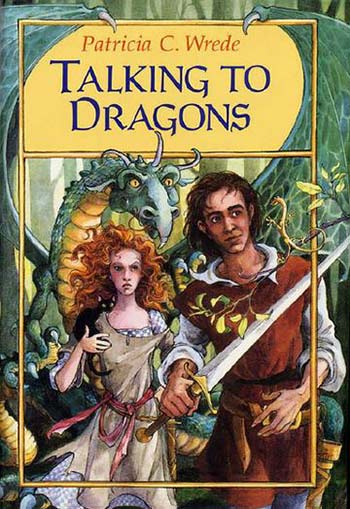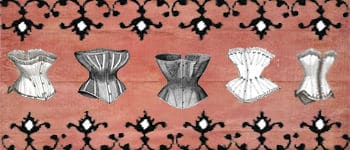
Talking to Dragons Book Review
I love the final book in a quartet. It has the unenviable job of wrapping up a story that has been building for at least two books while still keeping things fresh and exciting. Sometimes, the final book is the best book and sometimes, it’s disappointing, but it’s always a bit of a kick when the story you’re following comes to an end. Such is the case with the final book in The Enchanted Forest Chronicles, Talking to Dragons, by Patricia C. Wrede. Unlike with Calling on Dragons, this book provides closure for the series in what I have always found to be a very satisfying way.
The Enchanted Forest Chronicles, as a refresher, primarily deals with the interactions among three distinct groups; the Society of Wizards, the Kingdom of Dragons and the Kingdom of the Enchanted Forest. At about 200 pages each, these books are a fun and fairly quick read. Wrede somehow manages to convince her readers to take the world she has created seriously while they are laughing at it, writing in a humorous style that also conveys, when necessary, gravity.
Warning, there are some spoilers for the other three books in the series in this review, though I tried to keep most major spoilers for this book out. If you haven’t read the first three books, proceed with caution!
RELATED: Vintage YA Book Review: Calling on Dragons
Spoilers
Like I said, this book builds on the foundation established by the other books in the series. As before, we can only see in the mind of one character. There are two key differences between this book and the others in The Enchanted Forest Chronicles, however. First, this one picks up sixteen years after the events of Calling on Dragons, a bigger leap than the others. Secondly, this book is told by a new character, Daystar, and is narrated in his voice.
The other books in the series have focused on a character and followed them, but this is the first time a character has actually narrated for us. This is interesting because we as readers know things before Daystar does. As soon as he mentions that his mother’s name is Cimorene, the reader knows who he is and where he comes from, facts that he doesn’t learn until the end of the book.
As the story unfolds, Daystar learns who he is and what his heritage is, as the audience is reintroduced to old friends and caught up on the last sixteen years in this magical world. What have the wizards been up to? What happened to Mendanbar? How is Cimorene doing? And these questions are answered throughout the novel.
We start with Daystar, remembering what must have been the strangest day of his life. He starts by describing all the lessons that he learned, things that really weren’t typical for a peasant boy; music, sword fighting, reading, writing, and etiquette (both dragon and human), before moving into describing the day the wizard came. This is great because it sets up that Daystar, although we as readers know that he is the son of Cimorene and Mendanbar and the prince of the Enchanted Forest, knows nothing about the time lapse or the events of the last three books.
After he and his mother are visited by a wizard, Antorell, who has apparently been hunting for both them and a sword for sixteen years, Antorell is melted. Cimorene hands Daystar a sword and sends him into the Forest, telling him that he can come back when he knows why he had to leave. Daystar, as a child raised to be extremely polite, takes it a bit better than I personally would.
Daystar heads into the Forest, armed with what his mother has taught him. He quickly discovers that there is more to his sword and his quest than what his mother has told him and is determined to find out and do whatever it is he is supposed to do. It’s a vague quest, but it works. The vagueness fits into what has been established about this world and the conflict that we, as readers know is there. It’s a bit jarring, but still effective.
Daystar meets up with new characters and some familiar ones as well. Morwen, Telemain, and Kazul all appear and offer advice to our hero. Daystar gets advice from a regal lizard named Suz and teams up with a young fire witch named Shiara who has trouble using her powers. Together, they meet a dragon, avoid wizards and discover that Daystar’s sword is also called the Sword of the Sleeping King, capable of doing more than just fighting.
Daystar and Shiara meet many new characters, both good and evil, and find themselves becoming close friends. When Kazul tells them that there will be a battle and that Daystar because he can use the sword, is already involved, Shiara is determined to go with him into the castle to return the sword to the King inside, waking him up and defeating the wizards once and for all. Old characters that we remember from previous books come back for the final confrontation between the Enchanted Forest, the Dragons in the Mountains of Morning, and the Wizards. While we’re in the castle with Daystar, the battle rages on outside.
I really don’t want to spoil the ending of this one, because Wrede wraps it up so well. It’s just a solid ending, it doesn’t feel contrived, and it fits into the established order of magic and this universe. At least, I have always liked it.
As the story progresses, the reader learns more about the magic of the Enchanted Forest from someone who doesn’t know anything about it already, which is a really interesting direction to take it; we learn as he does. Wrede has clearly got a lot of information about her fictional world that has not yet been shared with us, and most of that has to do with the sword.
In Searching for Dragons, Mendanbar talks about how the sword and the Enchanted Forest choose the next king, by his proving himself to the Forest somehow. It’s set up as a complex magical system that only makes sense to the person who is wielding the sword. This is further emphasized in Calling on Dragons; the magic of the Enchanted Forest follows its own rules. The use of Daystar as a first-person narrator allows us to see how the magic works and how it affects the person who is using it, in a way that we couldn’t see when we were just hovering in Mendanbar’s mind.
Romance-wise, this book is a little odd. Firstly, Daystar and Shiara’s relationship is set up as an early stage of a romance, particularly noticeable when Shiara becomes Kazul’s princess. Cimorene unabashedly sets this up for two reasons: so that Shiara can learn more about her magic and so she can learn skills for when she becomes Queen of the Enchanted Forest later on. The story ends with Daystar determined to maintain his friendship with Shiara and acknowledging that he might feel a little more for her than that friendship. It’s also a nice romance because it’s not the main plot point; the main characters are on a quest that they don’t understand, so they are a little distracted.
The reason I gave the book the romance rating I gave it was because of the established relationships; Mendanbar and Cimorene and Morwen and Telemain. Mendanbar and Cimorene are a really sweet couple, and even though they don’t get much time together, their interactions and the things that Cimorene does to save her husband and her kingdom show the depth of their affection. It’s understated, and I think that makes it sweeter.
The other romance really came out of left field the first time I read the series, but rereading it I can see the hints dropped in earlier books. Morwen and Telemain have been friends before the series started (I would love a series about Morwen’s life because she’s a fascinating character), and after the battle decides to get married. They fit the Monica/Chandler mold in that they’re friends who slowly realize that they are perfect for each other, which I also love.
With these two couples and the hint of future romance for Daystar and Shiara, the story wraps up the plot of the series and gives me three different but satisfying and believable romances, all in less than 300 pages. Talking to Dragons is a satisfying conclusion to a wildly inventive and magical quartet of books.
Adaptation Recommendation
Again, I think this would be a delightfully whimsy-filled quartet of films. With the modern technology, the dragons and other enchanted aspects of the film could be portrayed on screen in a more realistic sense. The action in this film, in particular, would be fun to see translated to the big screen and while the magic of the Forest might be tricky, if they can make Smeagol work, I have confidence someone can figure this out. And, as before, I have some casting ideas! I still want Jemima West as Cimorene, Colin Morgan as Mendanbar, Emma Thompson as the voice of Kazul, Emma Stone as Morwen, Sam Neill as Willan (mostly because Zemenar was eaten at the end of the last book), Charlie Cox as Telemain, and Antorell as played by Andrew Garfield.
As far as the new characters go, I’m thinking that I would like to see Skandar Keynes (of Narnia fame) as Daystar. He could look like a young (well, younger) Colin Morgan, giving us as the audience more of a tie-in to the character of Mendanbar, his father. Also, he was an amazing Edmund, and I would love to see him in more things. As for Shiara, I think Bonnie Wright (Ginny from the Harry Potter Movies) would be a great fit. The dragon could be anyone, really, because it doesn’t have a gender yet; just a kid who has a dramatic voice.
I have other ideas for casting as well. Rose Leslie (from Game of Thrones) would be my choice for the bad fire witch, and the team of wizards would be made up of Sean Bean, Gary Oldman, Tom Hiddleston, Benedict Cumberbatch, Richard Madden, and Liam Neeson (with other similar talents and ranging in age. In my brain, they’re all from the UK). Zachary Levi would be the quozzel, and Michael Caine would be Suz.
OVERALL RATING
“The stuff that dreams are made of.”
ROMANCE RATING
“You pierce my soul. I am half agony, half hope. I have loved none but you.”
ARE YOU A ROMANCE FAN? FOLLOW THE SILVER PETTICOAT REVIEW:
 Our romance-themed entertainment site is on a mission to help you find the best period dramas, romance movies, TV shows, and books. Other topics include Jane Austen, Classic Hollywood, TV Couples, Fairy Tales, Romantic Living, Romanticism, and more. We’re damsels not in distress fighting for the all-new optimistic Romantic Revolution. Join us and subscribe. For more information, see our About, Old-Fashioned Romance 101, Modern Romanticism 101, and Romantic Living 101.
Our romance-themed entertainment site is on a mission to help you find the best period dramas, romance movies, TV shows, and books. Other topics include Jane Austen, Classic Hollywood, TV Couples, Fairy Tales, Romantic Living, Romanticism, and more. We’re damsels not in distress fighting for the all-new optimistic Romantic Revolution. Join us and subscribe. For more information, see our About, Old-Fashioned Romance 101, Modern Romanticism 101, and Romantic Living 101.


